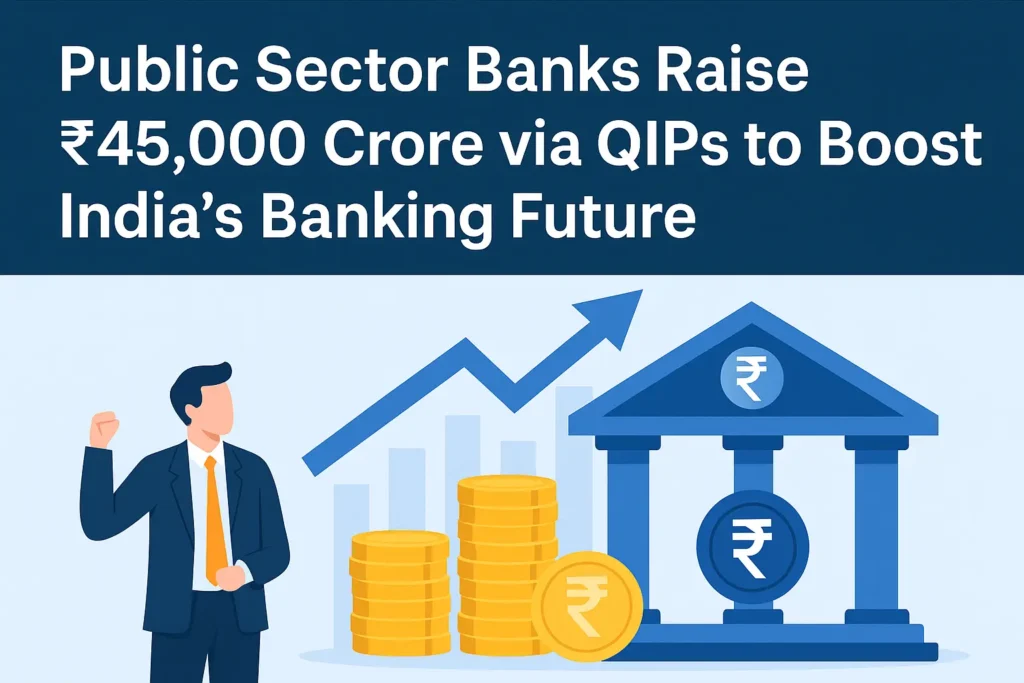
In the year 2025-26, public sector banks are planning something very big. Public Sector Banks Raise ₹45,000 Crore via QIPs to make themselves stronger and ready for future growth. The biggest bank in India, State Bank of India (SBI), alone will raise ₹25,000 crore. This step shows that public banks are confident and are preparing for better service, more loans, and digital improvements.
For example, after SBI’s last fundraise through bonds in 2021, it was able to expand into more rural areas and set up digital branches. This shows how fundraising can improve service and inclusion. The ₹45,000 crore will also support the push for India’s ₹5 trillion economy goal.
This blog will help you understand why Public Sector Banks Raise ₹45,000 Crore via QIPs and how this decision will shape the future of India’s banking and economic landscape. Public Sector Banks Raise ₹45,000 Crore via QIPs because they want to stay strong and modern in today’s changing financial world. This is not just a number—it reflects confidence in the strength of India’s public banks.
💡 What Are QIPs?
Public Sector Banks Raise ₹45,000 Crore via QIPs to get money quickly from big investors. QIP means Qualified Institutional Placement. It is a smart way for banks to sell shares to big investors like mutual funds and insurance companies without doing an IPO. This is faster and saves time.
Why it’s good:
-
Fast money for banks
-
No long SEBI process
-
Shares sold at market price
-
Makes banks financially strong
For instance, when Canara Bank raised ₹2,500 crore via QIP in 2020, it used the money to improve digital services and reduce bad loans. This success story shows that Public Sector Banks Raise ₹45,000 Crore via QIPs to create similar improvements across the entire banking sector.
So, when Public Sector Banks Raise ₹45,000 Crore via QIPs, they are getting the funds easily and preparing for future needs. Public Sector Banks Raise ₹45,000 Crore via QIPs as a smart and quick financial strategy to strengthen their foundation.
🏦 Why Public Sector Banks Are Raising ₹45,000 Crore
Public Sector Banks Raise ₹45,000 Crore via QIPs mainly to become stronger and help the economy. Here are some reasons:
-
To follow RBI rules under Basel III
-
To increase CET-1 capital (main safety money)
-
To give more loans to people and businesses
-
To improve technology and digital banking
For example, Indian Bank has plans to digitize more rural branches and launch new mobile banking features. This requires funding, and a QIP allows quick capital infusion. Public Sector Banks Raise ₹45,000 Crore via QIPs to support such projects without delay.
The RBI supports this move because Indian banks need more money to keep giving loans safely. A well-capitalized bank can lend more, support MSMEs, and help build infrastructure like roads and housing. That’s why Public Sector Banks Raise ₹45,000 Crore via QIPs to stay financially fit. Public Sector Banks Raise ₹45,000 Crore via QIPs because capital adequacy is essential for trust and progress.
📈 SBI Leads the Way with ₹25,000 Crore QIP
The biggest move in this plan is that the State Bank of India will raise ₹25,000 crore. This is a huge amount and shows how serious SBI is about growing. SBI has chosen top investment banks to help in this process.
By doing this, SBI can:
-
Open more branches
-
Improve mobile and internet banking
-
Give more loans
-
Be strong against bad loans
In 2017, when SBI merged with its associate banks, it needed large capital to manage the transition. Raising money through instruments like QIPs made that process smooth. In 2025-26, Public Sector Banks Raise ₹45,000 Crore via QIPs to handle similar big plans with ease.
This is the first time in 8 years SBI is raising money like this. It’s a big part of why Public Sector Banks Raise ₹45,000 Crore via QIPs this year and signals confidence in future growth. Public Sector Banks Raise ₹45,000 Crore via QIPs with SBI at the front to show the entire sector is ready for expansion.
📊 Fundraising Plan of Other Public Sector Banks
Other banks are also raising money in this way. Here’s a table:
| Bank Name | Estimated QIP Amount (₹ Cr) |
|---|---|
| State Bank of India | 25,000 |
| Bank of Baroda | 5,000 |
| Punjab National Bank | 3,500 |
| Canara Bank | 3,000 |
| Union Bank of India | 2,500 |
| Indian Bank | 2,000 |
| Central Bank of India | 1,500 |
| UCO Bank | 1,000 |
| Punjab & Sind Bank | 500 |
| Indian Overseas Bank | 500 |
Bank of Baroda has already announced its intention to use the funds to expand its operations in Tier 2 and Tier 3 cities. Similarly, Punjab National Bank is investing in digital banking and cybersecurity systems. These examples show how Public Sector Banks Raise ₹45,000 Crore via QIPs to modernize and grow.
All these banks are working together. This is why Public Sector Banks Raise ₹45,000 Crore via QIPs in FY 2025-26 to meet rising demand and improve banking infrastructure across India. Public Sector Banks Raise ₹45,000 Crore via QIPs because strong collaboration means a strong future.
📛 Government’s Disinvestment Plan in Public Sector Banks
Public Sector Banks Raise ₹45,000 Crore via QIPs as part of the Indian government’s broader disinvestment strategy. The government wants to reduce its stake in public sector banks and invite more private investment. This helps banks become more competitive and efficient.
For example, the government is likely to complete the IDBI Bank disinvestment by October 2025. It has also shown interest in stake sales for UCO Bank, Central Bank of India, Indian Overseas Bank, and Punjab & Sind Bank. These banks are being considered for increased private sector participation to improve performance.
These efforts will lead to better governance, faster decision-making, and reduced pressure on the central budget. When Public Sector Banks Raise ₹45,000 Crore via QIPs, it also supports this policy by allowing the government to dilute its stake without issuing fresh capital from taxpayers.
🔐 What is CET-1 Capital and Why It Matters
CET-1 (Common Equity Tier 1) capital is the main capital that banks must keep as a safety reserve. This reserve protects the bank from any unexpected financial loss. RBI has made it clear that every bank must maintain a healthy CET-1 ratio.
Public Sector Banks Raise ₹45,000 Crore via QIPs to directly boost this CET-1 capital. A good CET-1 level makes banks stronger during any financial crisis. For instance, banks with better CET-1 ratios during COVID-19 were able to lend more and help businesses recover.
Higher CET-1 capital also means the bank can lend more without taking risks. This builds trust among investors and customers. So when Public Sector Banks Raise ₹45,000 Crore via QIPs, it gives them more stability and resilience in the long run.
💼 Impact on Investors
Public Sector Banks Raise ₹45,000 Crore via QIPs not just to benefit themselves but also investors. Institutional investors such as mutual funds and pension funds get an opportunity to buy shares at market rates. This often shows confidence in the bank’s long-term potential.
Retail investors may not directly participate in QIPs, but they can benefit indirectly. When the bank becomes stronger, its share prices may go up. That means investors holding PSB stocks in their portfolio could see good returns over time.
There might be a small dilution of shares if existing shareholders do not take part in the QIP. But overall, the capital infusion helps banks grow faster, which benefits all investors. That’s why Public Sector Banks Raise ₹45,000 Crore via QIPs is seen as a positive step by market experts.
How This Will Help the Indian Economy
Public Sector Banks Raise ₹45,000 Crore via QIPs to support India’s fast-growing economy. More capital means more loans to small businesses, startups, and infrastructure projects. This boosts employment and increases demand across sectors.
Banks with strong capital can also invest in modern services like mobile banking, customer service upgrades, and new rural branches. When more people get access to banking, the whole economy grows faster. This supports India’s dream of becoming a $5 trillion economy.
In recent years, India has focused on financial inclusion and digital growth. Public Sector Banks Raise ₹45,000 Crore via QIPs to push this vision ahead by funding innovation and clean energy projects. This step matches with India’s digital, inclusive, and sustainable future goals.
📘 Regulatory Framework for QIPs
Public Sector Banks Raise ₹45,000 Crore via QIPs by following rules made by SEBI. These rules are part of the SEBI (Issue of Capital and Disclosure Requirements) Regulations. They make sure the QIP process is clean, fair, and transparent.
Key rules include:
-
No lock-in for institutional investors
-
Minimum 10% of total QIP should be allotted to mutual funds
-
Pricing is based on the volume-weighted average market price of past two weeks
-
RBI and SEBI both monitor every QIP closely
These guidelines help keep the process smooth and prevent any misuse. Public Sector Banks Raise ₹45,000 Crore via QIPs under a system that builds investor trust and ensures transparency.
🌟 Conclusion
The decision by Public Sector Banks to Raise ₹45,000 Crore via QIPs in FY 2025-26 is bold and necessary. It proves that Indian banks are growing stronger and preparing for future demand. With SBI leading this wave and the government showing support, QIPs will bring in more private capital and reduce dependence on public funds.
Public Sector Banks Raise ₹45,000 Crore via QIPs not just to benefit themselves but to support India’s progress. It will help MSMEs, create jobs, improve banking access, and boost economic development. For investors, this is a golden chance to invest in India’s growth story.
❓FAQs: Public Sector Banks Raise ₹45,000 Crore via QIPs
Q1. What is a QIP?
A QIP is a method by which listed companies raise capital by issuing shares to qualified institutional buyers without the need for a public offering.
Q2. Why is SBI raising ₹25,000 crore?
SBI is raising funds to strengthen its CET-1 capital, fund future growth, and improve lending capacity.
Q3. Will this impact the share price of PSBs?
Share prices may show short-term movement, but long-term gains are expected due to stronger capital and business expansion.
Q4. Is this capital raise approved by SEBI?
Yes, all QIPs must follow SEBI regulations and disclosures.
Q5. What is CET-1 capital?
CET-1 is a bank’s core capital, which absorbs losses and ensures financial strength during economic stress.
Q6. Can retail investors buy QIP shares?
QIPs are only offered to qualified institutional buyers. However, stronger banks can benefit retail investors indirectly through stock market performance.
Q7. Which banks besides SBI are raising funds?
BoB, PNB, Canara Bank, Union Bank, and others are also raising capital in FY 2025-26.
Q8. What is the government’s goal in reducing stake in PSBs?
To improve governance, efficiency, and reduce fiscal load.
Q9. Will this QIP help India’s economy?
Yes, more capital means more loans, better services, job creation, and stronger economic growth.
Q10. Is this part of the budget plan?
Yes, the 2025-26 Union Budget has a ₹47,000 crore target for stake sales and asset monetisation, which includes QIPs.
Also Read This
Aadhaar Biometric eKYC for RD & PPF at Post Offices – Go Paperless Today
RBI Pre-payment Charges Rules 2025: What Borrowers Must Know
UPI Transaction Updates 2025: New Rules, Global Access & Smart Features
- 8th Pay Commission Explained: Powerful Benefits, Expected Salary Hike & Impact on Pensioners
- Retirement Planning: How Much Money Do You Need for Financial Freedom in India?
- Best Crypto to Invest for Good Profit: Top Coins for Safe and High Returns
- The Psychology of Stock Market Investing: Mastering Your Mind for Success

